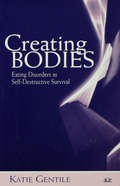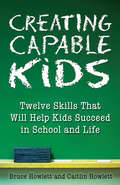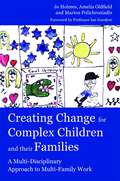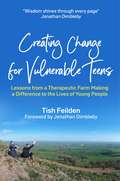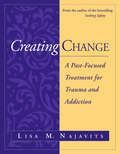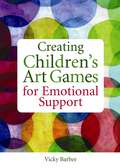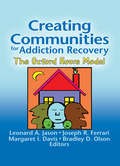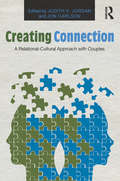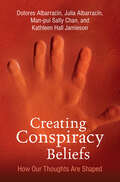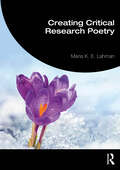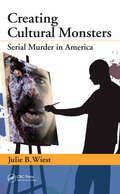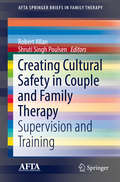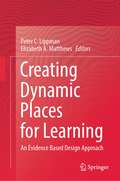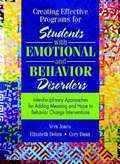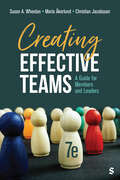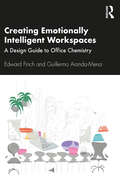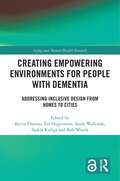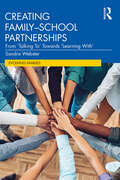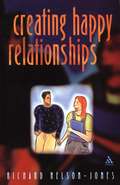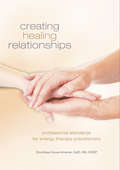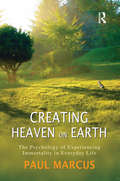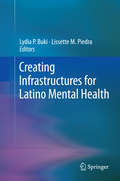- Table View
- List View
Creating Bodies: Eating Disorders as Self-Destructive Survival (Relational Perspectives Book Series #33)
by Katie GentileAmid the welter of clinical studies, memoirs, and other death-defying tales of eating disorders, we remain unclear about the relationships among trauma, anorexia, and bulimia, and about the psychological pathways to recovery. Creating Bodies offers the gripping story of healing and transformation detailed in one woman's diaries. Hannah wrote 18 diaries between the ages of 14 and 32. In the excerpts reprinted herein, we watch Hannah navigate violent adolescent friendships, descend into anorexia and bulimia, marry an abusive man, struggle to recover memories of sexual abuse, and finally to heal. And we learn of her interaction with Katie Gentile, who analyzed her diaries and met with Hannah to discuss the latter's own understanding of the diaries and of the diary analysis. Through a close study of both the content and structure of Hannah's diaries, Gentile shows how unspeakable, embodied remnants of sexual trauma become symbolized and how, within this process, Hannah's bulimia functioned as both an act of self destruction and a lifesaving form of resistance. Anchored in relational psychoanalysis and critical feminist theory, Creating Bodies provides a uniquely longitudinal account of the development of, and ultimate recovery from, an eating disorder fueled by childhood sexual abuse. An invaluable contribution to the literature on adolescent and adult eating disorders, it is also a thoughtful meditation on how the act of writing deepens issues of relationality and, over time, promotes cure. Psychoanalysts will be intrigued by the rich process issues embedded in prose journals, notes, and letters - both close to and distinct from clinical process issues - that Gentile uses to understand Hannah's projects of self-destruction and reconstruction.
Creating Capable Kids
by Bruce Howlett Caitlin HowlettHere is a compelling, thought provoking and practical guide to parenting and educating today's children. It is derived from Amartya Sen's Nobel Prize-winning approach to human development which has proven highly effective at freeing people from the chains of poverty. Educators Bruce and Caitlin Howlett apply Sen's approach to child development at home and in school and offering fresh, effective ways to rescue parenting and revive education, while providing parents, teachers and caregivers with a proven foundation for creating rewarding childhoods, academic success and fulfilling lives. By incorporating the twelve key capabilities, such as sensory awareness, creative imagination, emotional and self-awareness, parents and educators can promote the three most critical tools for children's survival and success: continuous learning, problem solving, and increased knowledge and meaning. Using stories of three different types of children - Zoe, Mia and Daniel - the authors demonstrate the value of life and of the "Capabilities Approach" theory on how to cultivate inquisitive, actively engaged, motivated, perceptive and resilient children.
Creating Change for Complex Children and their Families: A Multi-Disciplinary Approach to Multi-Family Work
by Amelia Oldfield Marion Polichroniadis Jo Holmes Ian M GoodyerThe strain of caring for children struggling with severe and complex mental health needs affects the entire family. The staff at the innovative Croft Child and Family Unit have developed a unique approach of working intensively with the whole family, and encouraging them to share their experiences with other families, to instigate a complete change that will benefit all family members. Using detailed case studies to illustrate the model, the book focuses on the needs of children with a wide range of developmental, emotional and behavioural difficulties, and explores the complicated interactions between these children, their families and their communities. The care team includes nurses, psychiatrists, doctors, family therapists and creative therapists, social workers and teachers. They examine how to integrate a range of therapeutic interventions and how to use the powerful relationships that develop between professionals and families to enable positive, lasting changes. This book will be indispensable reading for trainees and professionals working with children with mental health problems and their families, and special needs educationalists wanting to understand the benefits of an intensive, multi-family approach to treatment for children who do not respond to standard community interventions.
Creating Change for Vulnerable Teens: Lessons from a Therapeutic Farm Making a Difference to the Lives of Young People
by Tish FeildenCreating Change for Vulnerable Teens tells the story of Tish Feilden and Jamie's Farm - a network of therapeutic farms dedicated to transforming the lives of disadvantaged children.Documenting Tish's experiences of working with truly remarkable teens who have faced huge challenges in their lives, the book describes how the farms help young people to thrive academically, socially and emotionally. She shares the approaches they have pioneered, including the critical importance of trust, of looking behind the behaviour and of really connecting with the desires and hopes of young people. If you have an interest in supporting vulnerable children or young people, this book provides a wealth of inspiration and ideas you can use, whatever the setting.
Creating Change: A Past-Focused Treatment for Trauma and Addiction
by Lisa M. NajavitsThis flexible, evidence-based manual offers counselors a gentle, compassionate approach to help people with trauma, addiction, or both explore their past. Creating Change guides clients to understand how trauma and addiction arose over time, grieve losses and regrets, create a new perspective on their life story, and take pride in their survival. The manual has 23 topics that can be implemented in any order with individuals or groups. Topics include Relationship Patterns, Break the Silence, Deepen Your Story, Darkness and Light, Emotions and Healing, and Influences: Family, Community, Culture. Creating Change can be implemented with any other treatment, including the author&’s present-focused model, Seeking Safety. The book has a convenient large-size format and includes 70 reproducible handouts, many of which can be downloaded and printed at the companion website. See also Seeking Safety: A Treatment Manual for PTSD and Substance Abuse, and the self-help guide Finding Your Best Self, Revised Edition: Recovery from Addiction, Trauma, or Both, an ideal client recommendation.
Creating Children's Art Games for Emotional Support
by Vicky BarberGame playing is a highly effective way of engaging children and has long been acknowledged as an important means of psychological therapy. This book offers an abundance of fun games that help children to confront personal problems and issues in a light-hearted yet meaningful way. These are games with a difference, as they must be constructed before they can be played. The creation aspect involves collaboration and cooperation within a team, and instils an empowering sense of ownership in the creators. By the time the game is ready to be played, children are confident, thoroughly engaged and ready to explore issues in a supportive environment. Each game has been tried and tested by the author, and is proven to really work. This book is an essential tool for therapists, counsellors, social workers, youth workers and teachers supporting children and young people.
Creating Communities for Addiction Recovery: The Oxford House Model
by Leonard A. Jason Bradley D. Olson Joseph R. Ferrari Margaret I. DavisLearn to create a positive research/action alliance similar to that of DePaul University and the Oxford House communityThis book reviews important research conducted in a 13-year collaborative partnership between Oxford House (a community-based, self-run residential substance abuse recovery program) and DePaul University. It also presents practical guidelines for developing effective action research collaborative programs that can cultivate and maintain mutually beneficial community/research partnerships.Creating Communities for Addiction Recovery: The Oxford House Model presents and examines: practical guidelines for developing effective action research collaboratives focusing on the development of trust, respecting the personal experiences of the community members and the group, commitment to serving the community, validating findings with organization members, and accountability the experiences and attitudes of Oxford House community members in light of their participation in the collaborative research projects described in the book the essentials of designing and creating an efficient and productive yet homey residential community environment for addicted persons the factors that make Oxford Houses in the United States and Australia "safe and sober" settings for persons in recovery the differential growth among self-governed substance abuse recovery homes for men and for women-with a focus on the impact of state loan programs and the utilization of technical assistance in relation to the expansion of women&’s houses as compared with men&’s the economic advantages of the Oxford House model as compared with other treatment and incarceration alternatives the roles of ethnicity and gender in substance abuse recovery the structural social support of Oxford House men-and the impact of parenthood on these men&’s substance use patterns and recovery attempts the medical care (need and utilization) patterns of a substance abusing and recovering population how Oxford House&’s African-American community functions as a source of abstinent social networks the sense of community among women and women with children living in Oxford Houses-with emphasis on how the presence of children impacts the household perspectives of leadership by women (some with children, some without) affiliated with Oxford HousesThe information in this book shows that the rules of the game have changed. Substance abusers now can take charge of their own recovery in effective and efficient ways, and practitioners can find low-cost housing options for their clients with substance abuse problems. As a part of your professional/teaching collection, Creating Communities for Addiction Recovery can help you or your students take understand and make effective use of this rapidly evolving paradigm of community-based recovery.
Creating Connection: A Relational-Cultural Approach with Couples (Routledge Series on Family Therapy and Counseling)
by Jon Carlson Judith V. JordanRelational-Cultural Therapy (RCT) is developed to accurately address the relational experiences of persons in de-valued cultural groups. As a model, it is ideal for work with couples: it encourages active participation in relationships, fosters the well-being of everyone involved, and acknowledges that we grow through and toward relationships throughout the lifespan. Part and parcel with relationships is the knowledge that, whether intentionally or not, we fail each other, misunderstand each other, and hurt each other, causing an oftentimes enduring disconnect. This book helps readers understand the pain of disconnect and to use RCT to heal relationships in a variety of settings, including with heterosexual couples, lesbian and gay couples, and mixed race couples. Readers will note a blending of approaches (person-centered, narrative, systems, and feminist theory), all used to change the cultural conditions that can contribute to problems: unequal, sometimes abusive power arrangements, marginalization of groups, and rigid gender, race, and sexuality expectations. Readers will learn to help minimize economic and power disparities and encourage the growth of mutual empathy while looking at a variety of relational challenges, such as parenting, stepfamilies, sexuality, and illness. Polarities of “you vs. me” will be replaced with the healing concept of “us.”
Creating Conspiracy Beliefs: How Our Thoughts Are Shaped
by Kathleen Hall Jamieson Dolores Albarracin Julia Albarracin Man-pui Sally ChanConspiracy theories spread more widely and faster than ever before. Fear and uncertainty prompt people to believe false narratives of danger and hidden plots, but are not sufficient without considering the role and ideological bias of the media. This timely book focuses on making sense of how and why some people respond to their fear of a threat by creating or believing conspiracy stories. It integrates insights from psychology, political science, communication, and information sciences to provide a complete overview and theory of how conspiracy beliefs manifest. Through this multi-disciplinary perspective, rigoros research develops and tests a practical, simple way to frame and understand conspiracy theories. The book supplies unprecedented amounts of new data from six empirical studies and unpicks the complexity of the process that leads to the empowerment of conspiracy beliefs.
Creating Critical Research Poetry
by Maria K. LahmanCreating Critical Research Poetry critically engages with the ways in which researchers can poetically approach textual representations that narrate the unnarratable and contest the uncontested.This text provides a rich path for early research poets to engage with and bloom and established research poets to dig deeper and flourish.Connections to literary poetry and critical social science theories are detailed. First-person poetic accounts where poets describe early fruitful engagement with poetic forms are highlighted. Free verse, formed poetry, and dimensional poems (e.g. concrete poetry) are covered in depth, with guidance for developing a poetic sensibility and honing research poetry craft. Poetic experiences are integrated throughout the book, which may be engaged with individually, as a group, and in virtual or face-to-face courses.Each chapter provides reflexive questions for the reader to engage with in their own journal writings, a poem creation exercise, and further poetic resources. Set within critical theories, Creating Critical Research Poetry provides a context for early research poets, and thought-provoking possibilities for seasoned research poets. This is the perfect entry point to this burgeoning field of critical inquiry and qualitative research.
Creating Cultural Monsters: Serial Murder in America
by Julie B. WiestProviding a comprehensive exploration, this volume explains connections between American culture and the incidence of serial murder, including reasons why most identified serial murderers are white, male Americans. Presenting empirically supported arguments that have the potential to revolutionize how serial murder is understood, this volume includes an illustrated model that explains how people utilize cultural values to construct lines of action according to their cultural competencies. It demonstrates how the American cultural milieu fosters serial murder and the creation of white male serial murderers and provides a critique of the American mass media‘s role in the notoriety of serial murder.
Creating Cultural Safety in Couple and Family Therapy: Supervision and Training (AFTA SpringerBriefs in Family Therapy)
by Robert Allan Shruti Singh PoulsenThis important resource offers theoretical and practical approaches to understanding and working with cultural realities in training and supervision, particularly in family therapy. Clinical wisdom, empirical findings, real-world examples, and hands-on suggestions demonstrate the vital role of building and sustaining cultural awareness, both in supervisory work with trainees and in therapists providing fair, effective, and relevant services to clients. In the book's multiple perspectives on the complexities of cultural identity, the attainment of cultural safety is shown as an ongoing process, part of professional development as well as self-knowledge across the lifespan. Critical distinctions are also drawn between cultural safety and relatively static concepts within cross-cultural competencies. Included in the coverage: A framework for integrating an understanding of oppression dynamics in clinical work and supervision. Expanding conversations about cultural responsiveness in supervision. When dominant culture values meet diverse clinical settings: perspectives from an African American supervisor. Safety and social justice in the supervisory relationship. Towards safe and equitable relationships: sociocultural attunement in supervision. Comprehensive multicultural curriculum: self-awareness as process. Developing cultural awareness and sensitivity through simulation. Creating Cultural Safety in Couple and Family Therapy will enhance the work of social workers, mental health professionals, and practitioners working family therapy cases seeking perspectives on addressing diverse multicultural realities as they intersect with clinical supervision and training.
Creating Dynamic Places for Learning: An Evidence Based Design Approach
by Peter C. Lippman Elizabeth A. MatthewsThis book showcases how an evidence-based design approach can be utilized in the planning of learning environments, by acknowledging the interconnectedness of research, practice, and theory as core considerations in the design of learning environments. Toward this end, this volume explores a multi-disciplinary perspective that draws upon modern learning theories, and empirical research from the fields of environmental psychology education, and architectural practice. By presenting this information in an accessible manner, it enables researchers, educators and designers to take actionable steps needed to re-imagine their settings and create dynamic places for learning.
Creating Effective Programs for Students with Emotional and Behavior Disorders
by Cory Dunn Elizabeth Dohrn Vern JonesThis exiting new book provides special educators, school psychologists, and others responsible for programs for students serving students with EBD with specific methods, supported by sound research and proven by practice, for developing or improving services to this student population. While several current books provide excellent discussions concerning characteristics of students with EBD and describe some methods that have been effective in helping these students improve their behavior, this is the only book to provide a thorough, comprehensive examination of concepts and strategies needed to effectively develop and implement a program for this student population. special educators, school psychologists, therapists.
Creating Effective Teams: A Guide for Members and Leaders
by Susan A. Wheelan Maria Åkerlund Christian JacobssonCreating Effective Teams: A Guide for Members and Leaders provides expert-backed strategies for cultivating top-performing teams across public and private industries. The updated Seventh Edition offers cutting-edge methodologies tailored to modern work dynamics, supporting maximum productivity and collaboration.
Creating Effective Teams: A Guide for Members and Leaders
by Susan A. Wheelan Maria Åkerlund Christian JacobssonCreating Effective Teams: A Guide for Members and Leaders provides expert-backed strategies for cultivating top-performing teams across public and private industries. The updated Seventh Edition offers cutting-edge methodologies tailored to modern work dynamics, supporting maximum productivity and collaboration.
Creating Emotionally Intelligent Workspaces: A Design Guide to Office Chemistry
by Edward Finch Guillermo Aranda-MenaEmotions in the workplace have until recently been seen simply as a distraction. We often think of work as rational, logical and non-emotional. But organisations are waking up to the key role of emotions and affect at work. Emotions influence how we make decisions, how we relate with one another and how we make sense of our surroundings. Whilst organisations are slowly embracing the pivotal role of emotions, designers and managers of workplaces have been struggling to keep up. New insights from hard sciences such as neuropsychology are presenting a radically different interpretation of emotions. Yet workplace designers and facilities managers still rely on measuring non-specific states such as satisfaction and stress. In this book we attempt to capture modern-day interpretations of emotion, looking at emotion in terms of transactions and processes rather than simple cause and effect. We entertain the idea of an ‘emotionally intelligent building’ as an alternative to the much-hyped intelligent building. The assertion is that we should create environments that are emotionally intelligent. Rather than focusing on the aptitudes or shortcomings of individuals at work, we should place closer attention on the office environment. It’s not that we are emotionally disabled – it’s the environment that disables us! The ability of you and me to interpret, control and express emotions may not simply be a result of our own make-up. A radically different outlook considers how our workspace and workplace debilitates or enables our emotional understanding. In the modern workplace there are many innovations that can undermine our emotional intelligence, such poorly implemented hot-desking or lean environments. Contrariwise there are key innovations such as Activity Based Working (ABW) that have the potential to enhance our emotional state. Through a series of unique case studies from around the world, we investigate key concepts that can be used by designers and facilities managers alike. No longer should designers be asked to incorporate emotional elements as intangible un-costed ‘add-ons’. This book provides a shot in the arm for workplace design professionals, pointing to a new way of thinking based on the emotional intelligence of the workplace.
Creating Empowering Environments for People with Dementia: Addressing Inclusive Design from Homes to Cities (ISSN)
by Eef Hogervorst Bob Woods Kevin Charras Sarah Wallcook Saskia KuligaThis edited volume addresses the environments that exacerbate, exclude, and stigmatise those living with dementia to explore designs and processes that can optimise well-being and independence.Featuring the voices and opinions of people with dementia, the chapters showcase individual homes, special dementia facilities, different forms of care homes, and public spaces, from landscape to urbanism, as examples of how to meet the needs and preferences for those living with dementia now. As a response to a recent Cochrane meta-analysis (2022) which highlighted the problems associated with using traditional, medically orientated evaluative methods for environmental design, this book demonstrates a range of research methods that can be used to inform and investigate good co-design of dementia-enabling environments. Furthermore, the book addresses cultural differences in people’s needs and illustrates past, ongoing, and novel initiatives worldwide.Ultimately, this timely volume focuses on person-centred design that enables empowerment, quality of life, health, and citizenship in people living with dementia. It will be of value to researchers, scholars, and postgraduate students studying gerontology, dementia specifically, and those involved with architecture and the built environment for societal benefit more broadly.
Creating Family–School Partnerships: From ‘Talking To’ Towards ‘Learning With’ (Evolving Families)
by Sandra WebsterIntroducing a new model of family–school partnership, entitled ‘Pathways to Partnership’, Sandra presents a template to teachers and school leaders for developing authentic, genuine family–school partnerships that reflect contemporary global thinking and practice. She offers a new perspective on the family–school partnership, and provides support and guidance to school leaders to move away from outdated but ingrained approaches to more effective family–school partnerships. Globally, schools are becoming less an education centre and more of a hub that integrates health and social services. With this change, the way schools regard family involvement has also shifted, with family involvement being viewed as a strategically critical role. This shift has been influenced not just by the recent pandemic, but also by the global trend towards decentralisation and democratisation of the decision-making power in schools, in which parent empowerment is implicit. However, many schools have not followed a modern engagement model in the way they approach partnership with the family, and still espouse approaches that are school centric and outdated in their orientation. Pathways to Partnership helps move leaders from ‘talking to’, towards ‘learning with’ parents. Using case studies and the voices of parents and teachers to bring the content to life, Sandra provides strategies for school leaders and teachers to use to establish contemporary partnerships with families, ones that reflect current thinking that leads schools into authentic collaboration with their most important partners.
Creating Great Choices: A Leader's Guide to Integrative Thinking
by Jennifer Riel; Roger L. MartinThe book includes fresh stories of successful integrative thinkers that will demystify the process of creative problem solving, as well as practical tools and exercises to help readers engage with the ideas. And it lays out the authors' four-step methodology for creating great choices, which can be applied in virtually any context. The result is a replicable, thoughtful approach to finding a "third and better way" to make important choices in the face of unacceptable trade‐offs.
Creating Happy Relationships: SAGE Publications
by Richard Nelson-Jones'Relate counsellors interested in extending their learning about cognitive therapy will find this manual a comprehensive guide'- Jan Hobbs, Relate News 'An easy-to-read, comprehensive text which provides a practical guide to skills for starting, maintaining and cultivating successful relationships, whether of opposite sexes or the same sex' - The Australian Journal of Counselling Psychology Creating Happy Relationships is written in a comfortable non-academic style, using simple everyday English, and incorporates recent research and theory. In addition to many vignettes of partners creating and cultivating happiness there are plenty of practical activities for improving partner skills. This book is a major resource for prospective partners, couples, for marriage preparation and counselling courses, and human communication and relationship education courses in schools, colleges and universities.
Creating Healing Relationships: Professional Standards For Energy Therapy Practitioners
by Dorothea Hover-KramerHealing work isn't just about what happens in the therapy room, but also about how practitioners communicate with integrity and act in their professional and personal relationships. While gifted healers are being trained in hundreds of modalities worldwide, few genuinely professional organizations exist and, in most cases, standards of relational ethics have yet to be codified. In the best of cases, well-meaning practitioners are thereby limited in their work to provide optimal service--and, in the worst cases, they are left vulnerable to potential legal repercussions and relational liabilities. Creating Healing Relationships is the first book to seriously address the need for professional standards in the rapidly growing field of energy healing and to demonstrate how the ethic of human caring can be translated into professional standards for safe and successful energy therapy practice.
Creating Heaven on Earth: The Psychology of Experiencing Immortality in Everyday Life
by Paul MarcusThe art of living the "good life" requires skilful attunement to the lovely presences in everyday life. Lodged in a psychoanalytic sensibility, and drawing from ancient and modern religious and spiritual wisdom, this book provides the details, conceptual structures, and inner meanings of a number of easily accessible, everyday activities, including gardening, sport, drinking coffee, storytelling, and listening to music. It also suggests how to best engage these activities, to consecrate the ordinary in a way that points to experiential transcendence, or what the author calls "glimpsing immortality", a core component of the art of living the "good life".
Creating Images and the Psychology of Marketing Communication
by Lynn R. Kahle Chung-Hyun KimThe purpose of Creating Images and the Psychology of Marketing Communication is to advance the understanding of the concept of image as it is applied to various areas of interest. It also serves to meet the growing interest in image-related studies by the public and academics, and provides an innovative and holistic approach to the study of image. The text reflects the importance of brand leveraging as the sections cover in-depth discussion on cross-country and tourism images, corporate and sponsorship images, individual and celebrity images, and cultural and social images. It provides a comprehensive and holistic look at the concept of image: the topics range from theories of image creative to other image studies on a country, corporate, and individual level. The sections cover the major topics currently being debated in image marketing and the psychology of communications. Several new and innovative concepts are also introduced in the book.Creating Images and the Psychology of Marketing Communication is intended for academics and scholars (including students) in the interdisciplinary fields of consumer psychology, marketing, and communication.
Creating Infrastructures for Latino Mental Health
by Lydia P. Buki Lissette M PiedraLatinos are the fastest growing and largest minority group in the United States. In 2008, this group numbered over 47 million; by 2050, the population is expected to triple, reaching 133 million. Traditionally, Latinos have immigrated to large urban centers (e.g., New York, Los Angeles) that over long periods of time developed a complex infrastructure to receive new immigrants. Increasingly, new Spanish-speaking immigrants are moving into areas of the country previously unfamiliar to them. Although urban co-ethnic communities continue to be the destination of many newcomers, immigrants from Mexico, Central America, and South America in pursuit of low-skilled labor opportunities are settling in small towns and rural areas of the South and Midwest. This new demographic trend has resulted in the creation of the term "new growth communities," which refers to small rural areas that are now home to a small but rapidly growing Hispanic population. Unfortunately, these communities, which are now present in many states across the country (e.g., Illinois, North Carolina), lack the infrastructure necessary to meet the needs of Latino immigrants (e.g., access to health care, immigration assistance, and breaking down language barriers). The lack of an infrastructure and the lack of an established ethnic community to facilitate the assimilation of new immigrants present an ongoing challenge, especially in the area of Latino mental health. The volume focuses on dealing with systemic issues and on providing innovative ideas for development of infrastructure of services. This text will advance ways to understand and ameliorate mental health disparities both from research and experiential perspectives.
